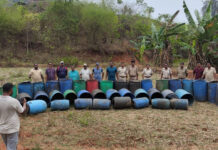The movement of the science is so rapid; we’re going to know a ton more in five or 10 years. We will then have a better idea of which organisms and ecosystems are most threatened, and may be able to advise policy makers on where to intervene to keep plastic out of the environment in the first place.
During a research cruise to the Sargasso Sea in fall 1971 marine biologist Ed Carpenter first noticed peculiar, white specks floating amidst the mats of brown sargassum seaweed. After some investigating he discovered they were tiny bits of plastic. He was stunned. If thousands of the broken down particles were showing up in the middle of the Atlantic Ocean, 550 miles from any mainland, he says, “I figured it’s all over the place.”
Carpenter, now at San Francisco State University, published his observations March 17, 1972, in Science. They were the first inkling plastic pollution is not limited to the plastic bags, soft drink bottles and other visible trash strewn along coastlines and gathering in the infamous Great Pacific Garbage Patch, a vortex of currents that concentrates debris in the Pacific Ocean. Weakened by sunlight and pulverized by winds and waves, those plastic products fracture into ever-smaller pieces. Along with the tiny, so-called microfibers shed by synthetic fabrics and the beads put in products like toothpaste, these fragments are called micro plastics. With 300 million metric tons of plastic produced each year—about the weight of the entire human population—trillions of degraded plastic bits may be lurking largely unseen in the environment, researchers say.
The miniscule dimensions of micro plastic—under five millimeters in diameter (about that of a grain of rice)—mean it can be ingested by a broader range of species than larger pieces, from tiny ocean plankton to humans. In animals’ bodies the waste can cause physical damage to organs and also, like a miniscule Trojan horse, ferry in hazardous chemicals and help them accumulate up the food chain.
An explosion of research to track micro plastics is revealing a mountain of plastic hidden not only in the oceans but in the world’s rivers, lakes, farm and soil as well as organisms big and small. The stuff is even floating around in the air—from dense urban areas to the remote Arctic Ocean. “It’s everywhere,” says Chelsea Rochman, a micro plastics researcher at the University of Toronto.
To understand the impacts—and how to curb the pollution—scientists need to know how much is concentrated in which places, where it is coming from and how it is moving around. Detecting micro plastics, though, is complicated by the dizzying array of tens of thousands of polymers they contain, as well as their wide size range—from the scale of that grain of rice down to a virus. “It’s not like you’re trying to sample a contaminant like mercury or lead,” says Richard Thompson, a marine biologist at the University of Plymouth who helped coin the term micro plastic. “It’s not a single thing, it’s many different things.”
HUNTING THE MISSING PLASTIC
Carpenter’s work provided a glimpse of the plastic soup in oceans, so that’s the first place scientists looked to try to determine how much was invading the environment. Although it took a few decades, a seminal study led by Thompson in 2004 found beach and coastal sediments off of Plymouth, England, teeming with the stuff. That’s when scientists really sat up and took notice. Since then they have found micro fiber sand fragments thought to primarily come from single-use packaging (which makes up 40 percent of all plastic produced) drifting around every ocean basin, in the bellies of marine species and even frozen in Arctic sea ice.The picture is improving but still incomplete. A 2015 study concluded that surveys of ocean micro plastics had turned up only 1 percent of the plastic estimated to be entering the oceans in one year from municipal solid waste. That means “we don’t know where 99 percent of the plastic actually is,” says Melanie Bergmann, a marine ecologist with the Alfred Wegener Institute for Polar and Marine Research (AWI).
Part of the problem is many of the studies done so far are not capturing the smallest pieces, which are thought to be the most abundant. By not relying on picking out particles by sight, as many studies have, Bergmann recently found 100 to 1,000 times as many micro plastic particles frozen in Arctic sea ice as the first such study did. Two thirds of what she found, using machines that read the chemical signature of plastics, was around 11 micrometers in diameter (about the size of a human red blood cell), below the previous study’s detection limit. Most sampling has also been in easy-to-reach surface waters, where levels are likely to change with currents and weather conditions. Those same conditions, along with films of bacteria and other matter that stick to plastics particles, can cause many of them to sink to the seafloor or gather along coastlines. The seafloor, however, is difficult to sample, although researchers could look at existing sediment cores, says Kara Lavender Law, an oceanographer at the Sea Education Association in Woods Hole, Mass. She also advocates better sampling of “what’s sitting literally pressed up against the coastline,” where much of the plastic is likely entering the ocean from rivers and beaches, especially nearly population centers, and where denser particles are likely to quickly sink.
More insight is expected soon from San Francisco Bay. With funding from environmental groups and the wastewater industry, the San Francisco Estuary Institute has collected thousands of samples from bay waters and sediments, the wastewater and storm water released into it, and nearby marine sanctuaries to see where different types of micro plastic is coming from and ending up. Sample analysis should be finished by the end of autumn. Then the information will be fed into a computer model to predict how micro plastics from different sources move through the region’s rivers, into the bay and out into the ocean. That is expected to reveal where the plastic is congregating and more likely to affect plant and animal life. The outcome should help researchers suggest how to target efforts to stop plastics from being emitted at the source—via policies like bag bans or technology like devices that pick up fibers in washing machines. “We’re pretty hopeful that we’re going to get some powerful results out of all this,” says project manager Rebecca Sutton.
CLOSER TO THE SOURCE
From the beginning scientists reasoned micro plastic in the ocean was primarily coming from land via rivers. That means the material should be in freshwater systems, too. But it was not until 2013 that anyone looked and definitively identified it in a lake. Since then researchers have found the tiny debris in lakes, rivers and freshwater beaches throughout the world—even seemingly pristine, remote water bodies such as mountain lakes in Mongolia. In many of these places researchers also found it in the stomachs of various freshwater species. The Great Lakes have been a particular locus of study. Micro plastic levels there are at least as high as those in trash-filled ocean gyres, which themselves contain only a portion of the estimated 15 trillion to 51 trillion plastic particles in the entire global ocean. Because rivers and lakes are closer to the original sources of plastic pollution, notably wastewater treatment plants and cities, Sherri Mason, a professor of chemistry at the State University of New York at Fredonia, had expected plastic particles to be bigger than those in the oceans because they would have had less time to degrade. That hasn’t been the case, suggesting to her “there’s a lot of degradation, I think, happening on land.” Researchers are still trying to more firmly connect the micro plastics found in lakes and streams back to their sources to confirm that, as well as chart their movement along waterways.
Sedimentary geologist Patricia Corcoran of Western University in Ontario has been doing such work by examining sediments in Ontario’s Thames River, which drains into Lake Saint Clair, tucked between lakes Huron and Erie. Most of what she has found is microfibers, likely from wastewater treatment plants, followed by fragments broken down from the polymers typically used in single-use packaging. Levels are generally higher near urban areas, and can be guided to particular areas by the water’s flow.
Because her initial work provided only a snapshot, Corcoran is re-sampling the Thames this summer. This time she is collecting smaller particles, down to 20 micrometers in diameter. She also wants to see how major spring floods affected micro plastic concentrations in the sediment—a study published in March found winter flooding flushed out tens of billions of micro plastic particles from river beds in England, presumably washing them out to sea. Corcoran will also be studying the Grand River, which flows into Lake Erie, to see how the two rivers compare. She hopes to continue sampling them to see how concentrations vary over time. “Things are very dynamic when it comes to accumulation of plastic,” Corcoran says, so continuous monitoring is needed to get a complete picture.
GLISTENING SOIL
The reservoirs of micro plastics go beyond waterways, notably to the soil in which farmers grow food. To fertilize their fields, some farmers use treated sewage sludge that is rich in nutrients—but also contains gobs of microfibers skimmed from wastewater. Estimates from Europe and North America suggest tens to hundreds of thousands of tons of microfibers may be added to farmland in those countries every year—and they can last for years in the soil after application. “It’s a mountain, basically,” says Luca Nizzetto, a research scientist at the Norwegian Institute for Water Research.
Other sources are adding to the plastic mass in the ground, including degraded plastic sheets that farmers use to retain soil moisture and stymie weeds, compost from bio-waste plants and so-called mixed waste—a ground-up amalgam of food scraps and unrecyclable material. A 2014 study in China showed up to 260 kilograms of plastic debris per hectare of cropland from flimsy sheets. A farm in Australia had applied so much mixed waste “that actually the whole topsoil was glistening,” says Mark Browne, an ecologist who specializes in micro plastics at the University of New South Wales.
All that plastic could affect the health of the soil by changing how it holds on to moisture or concentrating other contaminants, like pesticides. If the plastics penetrate deeply enough, they could reach groundwater; if they are very small, crops could absorb them. If earthworms and other small creatures ingest the stuff, it could travel up the terrestrial food chain.The first dedicated studies of micro plastic in soils are just taking off. Aquatic biogeochemist Jill Crossman of the University of Windsor in Ontario and Nizzetto are part of an international collaboration, funded by the European Commission, that is measuring micro plastic levels in agricultural fields before and after sludge application in both Canada and Spain as well as examining how much runs off into water and how deep the plastic penetrates into the ground. They aim to put that data into computer models to see how well different tactics to reduce the micro plastic load, like eliminating sludge applications, might work.
FALLING FROM THE SKY
Another source of micro plastics is right overhead. Microfibers picked up by winds from the ground or as it falls off clothing have long bedeviled scientists trying to limit contamination in their labs, so Rachid Dris and his colleagues at the University of Paris–Est decided to measure micro plastics falling from the sky. For three months in 2014 they collected what fell into funnels on the university’s roof. They found mostly fibers—the shape and lightness of which makes them more easily airborne—and in larger quantities than expected. On average they collected 118 particles per square meter per day, ranging in length from five millimeters down to 100 micrometers, or the thickness of a sheet of paper. But “we don’t know exactly what it means because it’s the first number that’s out there,” says Dris, now an ecologist at the University of Bayreuth in Germany.
Other numbers are on the way from several groups collecting samples in remote areas where the atmosphere is the only presumed source of micro plastics. Julian Aherne, a pollution modeler at Trent University in Ontario, has sampled the rainwater collected at weather stations on the remote west coast of his native Ireland, where the winds blow in from the ocean. His initial results show mostly fibers in numbers in line with Dris’s. This summer he is sampling the sediment of lakes in the Canadian Arctic. Other researchers are sampling the snow atop Arctic sea ice (separate from what is frozen in the ice, which comes from the ocean below). Falling snow, AWI’s Bergmann says, “carries everything with it that was in the atmosphere—in this case plastic fibers.”
Because atmospheric scientists already have a good handle on how other pollutants such as soot and sulfur dioxide (which causes acid rain) move around the atmosphere, Aherne thinks it will be possible to estimate how far different sizes and shapes of micro plastics are likely to travel on the wind and how long they might stay aloft. As more measurements roll in, he envisions creating something like a rainfall map, identifying global hotspots of micro plastic fallout.
THE NEXT BIG QUESTION
As scientists comb for micro plastics and move away from visual identification to machine sensors, they are finding the stuff at ever-smaller sizes. Most researchers think micro plastics are degrading even further into what they call nano plastics. These infinitesimal specks would be of even greater concern because if ingested, they are likelier to penetrate the gut lining to reach the bloodstream or if inhaled, lodge deep in the lungs. Such nano size fragments have been shown to form in lab experiments, so most researchers are confident they are out in the environment. But currently, “we don’t have any methods that will isolate nanoplastics” there, Thompson says. Several groups are working on developing ways to illuminate this hidden threat, including researchers at the AWI that have so far shown a way to identify known nanoplastics in samples. When such methods reach fruition, Bergmann expects “we will find that the ocean is much more polluted than we think now.” The same goes for other environments.
The research community is also working to weed out methods that can under or over estimate micro plastic numbers and to standardize methods so they can compare the results of different studies. Although “there’s still so much to be done, just in understanding the sources and the pathways and the abundance on all of these different systems,” as Mason says, it is becoming clear micro plastics, particularly microfibers, are pervasive, with some hotspots hewing close to populated areas. Experts are excited. “The movement of the science is so rapid, I think we’re going to know a ton more in five or 10 years,” Sutton says. They will then have a better idea of which organisms and ecosystems are most threatened, and may be able to advise policy makers on where to intervene to keep plastic out of the environment in the first place.
While the work to locate micro plastic continues, scientists are not losing any time tracing the harm it might be doing to organisms and ecosystems. That includes humans, through the health of the soils in which we grow our food, the quality of our drinking water and even more directly as we ingest it and breath it in. As Mason put it: “That’s the question that everyone wants to answer.”










































